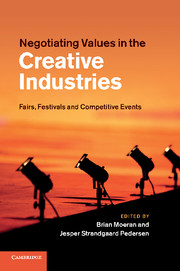Book contents
- Frontmatter
- Contents
- Figures
- Tables
- Contributors
- Acknowledgements
- Introduction
- 1 A Salon’s life
- 2 Art fairs
- 3 Biennalization and its discontents
- 4 Staging auctions
- 5 The book fair as a tournament of values
- 6 Inventing universal television
- 7 Transforming film product identities
- 8 Event institutionalization and maintenance
- 9 Tradition and transformation at the Fan Fair festival
- 10 Between art and commerce
- 11 Configuring sustainability at fashion week
- 12 An inconvenient truce
- 13 The retrospective use of tournament rituals in field configuration
- Afterword Converting values into other values
- Author index
- Subject index
- References
Introduction
Published online by Cambridge University Press: 25 October 2011
- Frontmatter
- Contents
- Figures
- Tables
- Contributors
- Acknowledgements
- Introduction
- 1 A Salon’s life
- 2 Art fairs
- 3 Biennalization and its discontents
- 4 Staging auctions
- 5 The book fair as a tournament of values
- 6 Inventing universal television
- 7 Transforming film product identities
- 8 Event institutionalization and maintenance
- 9 Tradition and transformation at the Fan Fair festival
- 10 Between art and commerce
- 11 Configuring sustainability at fashion week
- 12 An inconvenient truce
- 13 The retrospective use of tournament rituals in field configuration
- Afterword Converting values into other values
- Author index
- Subject index
- References
Summary
This book is about how those working in the creative industries take into account, negotiate and try to use to their advantage different kinds of values when participating in fairs, festivals and competitive events. It addresses three broad themes that cover the production, exchange and consumption of cultural or creative products. One concerns the nature of creative industries themselves and their production processes; another the role of fairs and festivals as institutions of economic and cultural exchange in the creative industries; and the third the ways in which different fields of cultural production are constituted and evolve through negotiation of the various values that different actors bring to bear on, and that ultimately extend to the consumption of, cultural products.
Creative industries
The – seemingly oxymoronic – notion of a ‘creative industry’ is an amalgam of two older terms that can be traced back to two separate sources. The first is ‘creative arts’, which derived from the philosophy of civic humanism espoused by the Earl of Shaftesbury and Sir Joshua Reynolds in England during the eighteenth century, and which came to be associated with an intellectual ideology of ‘public art’ (Hartley, 2005: 6–7). The second is ‘culture industry’, a term coined in 1947 by two members of the Frankfurt School, Max Horkheimer and Theodor Adorno, in their influential book, Dialectic of Enlightenment, to describe the role of media in contemporary society. This phrase was preferred to that of ‘mass culture’ because the authors wished to argue against the then prevalent idea that culture arose spontaneously from the masses themselves. Instead, they suggested that cultural products were carefully tailored for consumption by the masses and were thus manufactured more or less according to plan (Adorno, 1991: 85). For this reason, Adorno later explained, the expression ‘industry’ was not intended to be taken too literally. It did not refer strictly to production processes, but to the standardization of cultural products, as well as to the rationalization of techniques relating to their distribution (Adorno, 1991: 87). Both these terms, in their separate ways, were originally advocated in opposition to the commercial exploitation of creativity.
- Type
- Chapter
- Information
- Negotiating Values in the Creative IndustriesFairs, Festivals and Competitive Events, pp. 1 - 35Publisher: Cambridge University PressPrint publication year: 2011
References
- 15
- Cited by



